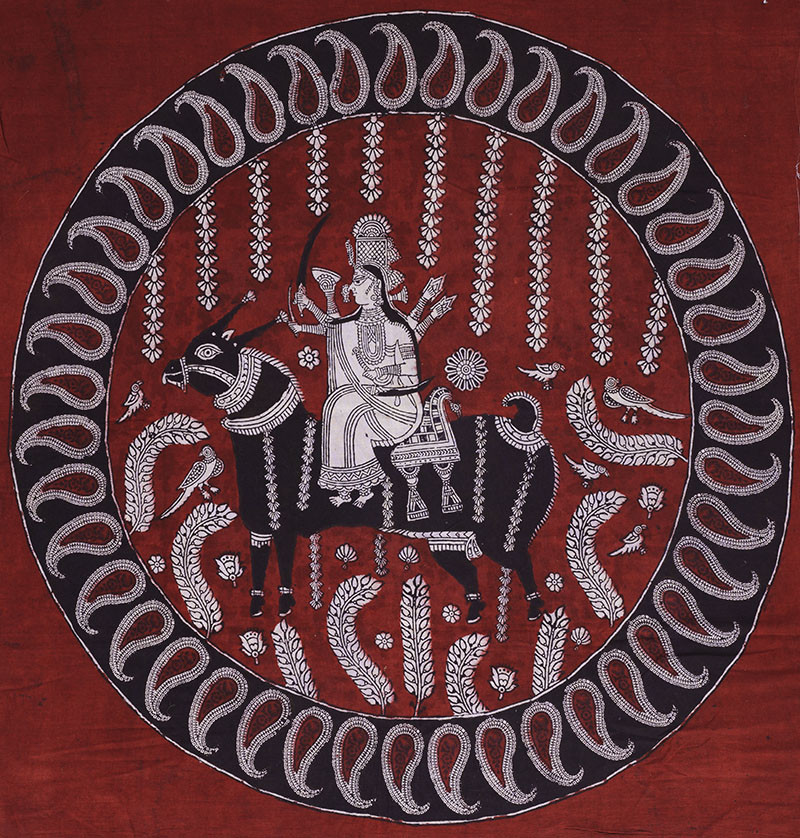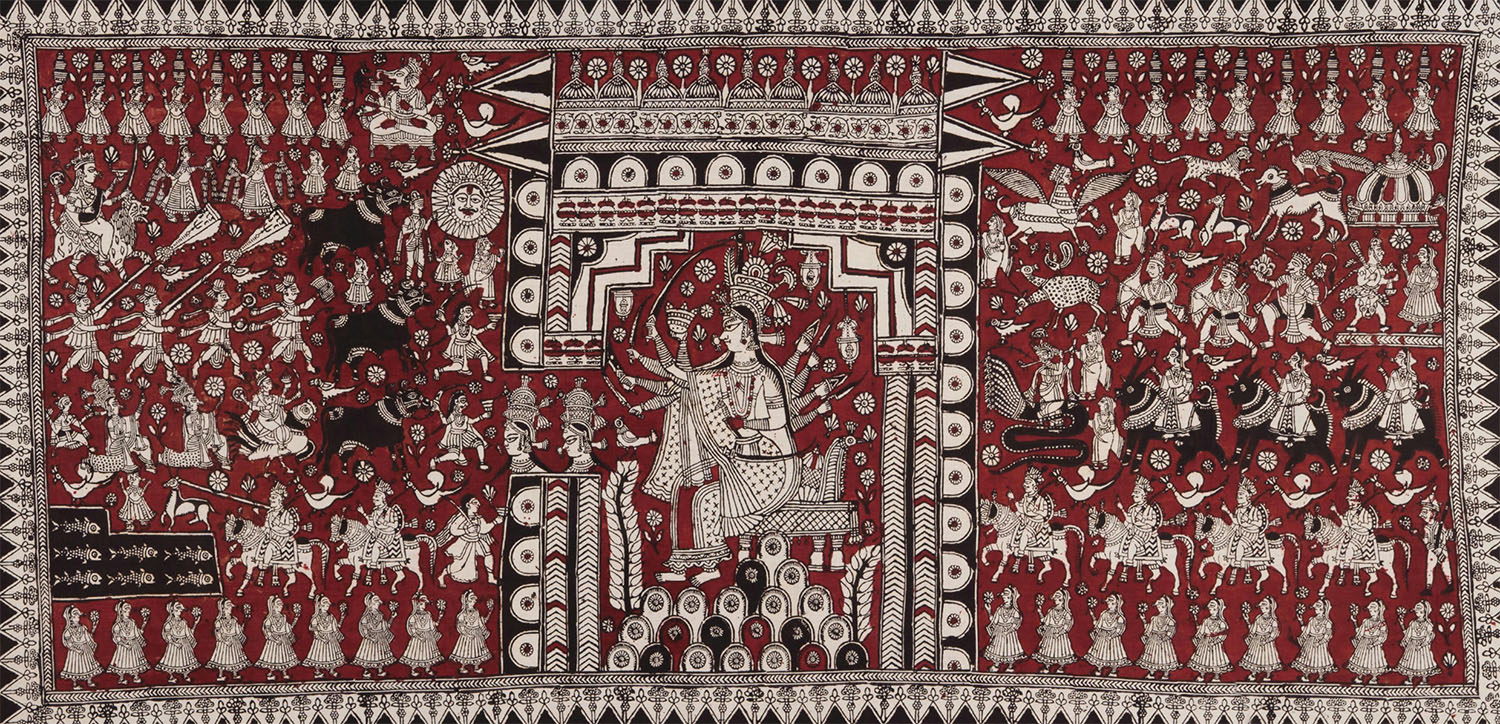ARTICLE
Mata ni Pachedi
In mata ni pachedi the figure of the goddess has a commanding presence, depicted flanked by worshippers, musicians and animals. Many forms of the goddess — known through mythological and oral narratives, textual sources, and popular local traditions — are found in these images, including various representations of the goddesses Durga and Amba. Also included are goddesses from the local folk tradition of Gujarat, such as Vishat Mata, one of the most important goddesses for the Vaghris, who claim their ancestry from her; Vahanvati Mata, who is worshipped by seafarers and traders; Momai Mata, more popularly known as Dashamaa, a goddess of the Kutch region and protector of health, livestock and harvest; Khodiyar Mata, who is thought to be powerful enough to predict the nature of incoming monsoon; and Hadkai Mata, who protects her flock from rabies. The pantheon of such local goddesses in the mata ni pachedi tradition serves to illuminate the social and cultural life of the Vaghris as a nomadic agricultural community dependent on monsoon rains, as well as Gujarat’s history of maritime trade.
Images of the goddesses in mata ni pachedi generally follow traditional iconographic conventions. In some versions, the Hindu god Ganesha appears in either the upper portions of the cloth or to the left of the goddess. Narratives from Mahabharata and Ramayana also find a portrayal, with artists improvising and adapting scenes from the texts to fit them into the mata ni pachedi painting conventions. For instance, the golden deer from the scene of Sita’s abduction in Ramayana is depicted instead simply as a two-headed deer since the colour gold was not available as a natural dye. Similarly, the game of dice from Mahabharata was substituted by a game of cards as the latter was easier to illustrate.
The need to improvise and adapt the form has led to significant changes in the art form; the grid-like structure for the narrative is no longer a requirement, and traditional depictions of rows of worshippers carrying garlands and flags have been supplemented by angels carrying them. In some cases, the temples also appear to be domed like mosques. To reduce costs and meet increased demand during the festive season, mata ni pachedi artists today have replaced natural dyes with a vast array of artificial colours, such as sap green, yellow ochre and dark blue.
The popularity of mata ni pachedi is no longer restricted to its ritual aspect and its significance during the nine-day Hindu festival of Navaratri. Artists now produce decorative consumer goods such as bedsheets, pillowcases, wall hangings and garments in the traditional style all year round.
Bibliography
Sarmaya. “A Mata-Ni-Pachedi Guide to Riding Like a Goddess”. Spotlight. June 26, 2019. https://sarmaya.in/spotlight/a-mata-ni-pachedi-guide-to-riding-like-a-goddess/.
Dastkari Haat Samiti. “How Mata ni Pachedi is Created.” Google Arts and Culture. Accessed August 6, 2021. https://artsandculture.google.com/exhibit/how-mata-ni-pachedi-is-created-dastkari-haat-samiti/MAKy_aQVxaGXJQ?hl=en.
Johnson, Donald Clay. “Challenging Tradition in Religious Textiles: The Mata Ni Pachedi of India.” Textile Society of America Symposium Proceedings for 14th Biennial Symposium, Los Angeles, September 10–14, 2014. https://digitalcommons.unl.edu/tsaconf/909/.
Joshi, Sandeep. “Kalamkari of Gujarat: Mata ni Pachhedi.” Sahapedia, April 17, 2017. https://www.sahapedia.org/kalamkari-of-gujarat-mata-ni-pachhedi.








![The façade of the Maneckji Seth Agiary, a Zoroastrian fire temple, is a standout example of the popularity of the Persian Revival Style in Western India in the 19th and 20th centuries. This style was often seen in the architectural patronage of the Parsis, who emerged as one of the most influential mercantile communities of British India. Popular motifs of this style, like the mythical lamasus (winged bulls with human heads) and the faravahar (a winged guardian spirit in Zoroastrianism), drew on the historical art and architecture of the Achaemenid and Sasanian empires from sites like Persepolis, Bisotun, Taq-e Bostan, Naqsh-e Rostam and Naqsh-e Rajab in Persia.
The Parsi community’s adoption of this style occurred largely due to their networks of global commerce and politics, allowing them to access and translate research of ancient Persia into visible symbols that underlined their association with antiquity, imperial power, and art.
نمای آتشکدهی زرتشتی مانِکجی سِت نمونهی بارزی از رواج سبک «احیای [معماری] ایرانی» در غرب هند طی سدههای نوزدهم و بیستم است. این سبک غالباً در بناهایی دیده میشد که پارسیان، از بانفوذترین جوامع بازرگان در هند بریتانیا، بانیشان بودند. نقشمایههای محبوب این سبک، مانند گاو بالدار اساطیری (لاماسو) و فَروَهَر (روح بالدار نگهبان در دین زرتشت)، برگرفته از هنر و معماری شاهنشاهی هخامنشی و ساسانی، در جاهایی چون تخت جمشید و بیستون و طاق بستان و نقش رستم و نقش رجب، بود.
اقتباس جامعهی پارسیان از این سبک بسیار مرهون روابط گستردهی تجاری و سیاسی آنها بود که دسترس به پژوهشها دربارهی ایران باستان و برگردانیدن آنها به نمادهای بصری را ممکن میکرد و بر پیوند پارسیان با دوران باستان و قدرت شاهنشاهی و هنر تأکید میکرد.](https://mapacademy.io/wp-content/plugins/instagram-feed/img/placeholder.png)
